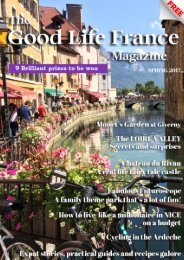Spring 2022
Discover Paris in the spring, Caen in Normandy and its marvellous markets plus Yvoire, a picturesque village on the edge of Lake Geneva in Haute-Savoie. Explore Saint-Omer, a historic city in the far north that's full of secrets and treasures, and Evian, where Frankenstein's monster stayed! Head with us to Metz in Lorraine to find out about its incredible past, La Couvertoirade, one of the prettiest villages in France, and the UNESCO heritage of Avignon. Guides, gorgeous photos, what's new in France, the best tours and delicious recipes from the legendary Le Nôtre bakery in Paris - and more.
Discover Paris in the spring, Caen in Normandy and its marvellous markets plus Yvoire, a picturesque village on the edge of Lake Geneva in Haute-Savoie. Explore Saint-Omer, a historic city in the far north that's full of secrets and treasures, and Evian, where Frankenstein's monster stayed! Head with us to Metz in Lorraine to find out about its incredible past, La Couvertoirade, one of the prettiest villages in France, and the UNESCO heritage of Avignon. Guides, gorgeous photos, what's new in France, the best tours and delicious recipes from the legendary Le Nôtre bakery in Paris - and more.
- No tags were found...
You also want an ePaper? Increase the reach of your titles
YUMPU automatically turns print PDFs into web optimized ePapers that Google loves.
Lost Monuments<br />
of Paris<br />
Sue Aran explores the history of two of Paris’s lost palaces…<br />
Paris is a city of contrasts – light and dark, old and new, past and present. Erased from the<br />
memories of most Parisians, however, are two buildings: the Palais du Trocadéro and the Palais<br />
Bardo. These ephemeral constructions of grandeur were richly imagined for the Paris World<br />
Fairs Expositions Universelle. Paris hosted seven world fairs beginning in 1855 and ending in<br />
1937. Visitors flocked from around the world and in 1900, Paris broke records with more than 50<br />
million visitors and 83,000 exhibitors at that year’s Fair.<br />
Palais du Trocadéro<br />
The Palais du Trocadéro was built<br />
for the Exposition Universelle of<br />
1878 by architect Gabriel Davioud.<br />
He was a colleague of Georges-<br />
Eugène “Baron” Haussmann, the<br />
urban planner who was responsible<br />
for the spectacular renovation of<br />
Paris during the reign of Napoléon<br />
III in the mid-19th century. Davioud<br />
designed most of the Parisian<br />
street furniture we see today,<br />
including the benches, lamp-posts,<br />
signposts, fences, balustrades,<br />
kiosks, pavilions, bandstands,<br />
monuments and fountains, the<br />
most recognizable of which is the landmark<br />
fountain at Place Saint-Michel.<br />
The Palais du Trocadéro was built on the hill<br />
of Chaillot, across the Seine from the Eiffel<br />
Tower in the 16th arrondissement. The Palais<br />
was named in honour of the 1823 Battle<br />
of Trocadéro in which the fortified Isla del<br />
Trocadero in Spain was captured by French<br />
forces under the leadership of the Duc<br />
d’Angoulême, the son of Charles X. Davioud<br />
conceived the elaborate palace as a pastiche<br />
of Byzantine and Moorish architecture where<br />
meetings of international organizations<br />
could be held during the fair. There was a<br />
large concert hall flanked by two 76-meter<br />
(249-foot) towers. The hall contained a large<br />
Palais de ChaillotPalais du Trocadero, Public domain, via Wikimedia Commons<br />
organ built by Aristide Cavaillé-Coll, the first<br />
large organ to be installed in a concert hall<br />
in France. It is still in use at the Auditorium<br />
Maurice Ravel in Lyon. The building proved<br />
unpopular, but the cost expended in its<br />
construction delayed its replacement for<br />
nearly 50 years, and the central building was<br />
finally demolished in 1937.<br />
It was replaced by the Palais de Chaillot<br />
for the International Exhibition of Arts and<br />
Techniques held in 1937. The wings of the<br />
Palais du Trocadéro were reused for the<br />
Chaillot building. It’s now home to four cultural<br />
institutions: the City of Architecture and<br />
Heritage, the National Maritime Museum, the<br />
The Good Life France | 57

















